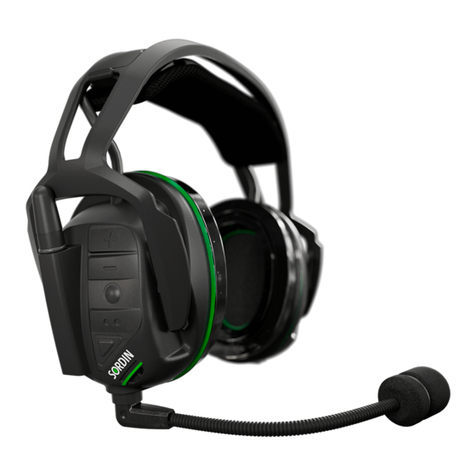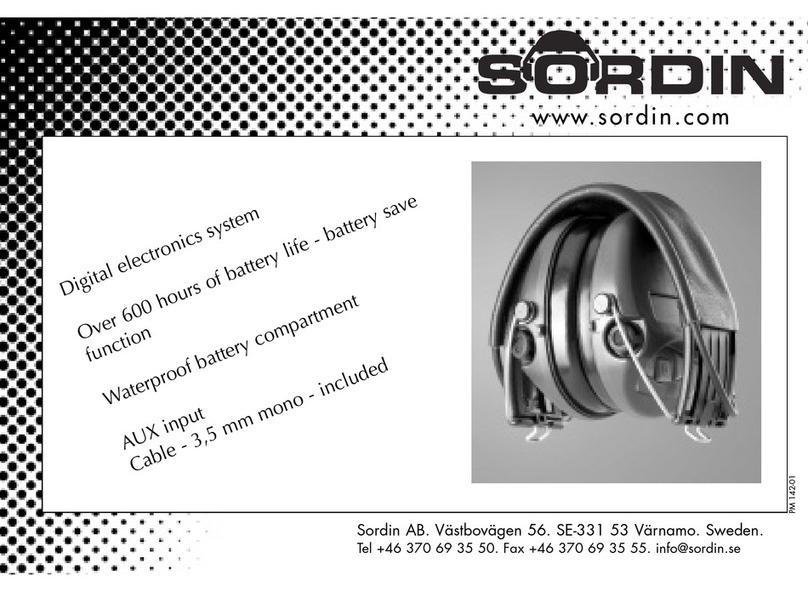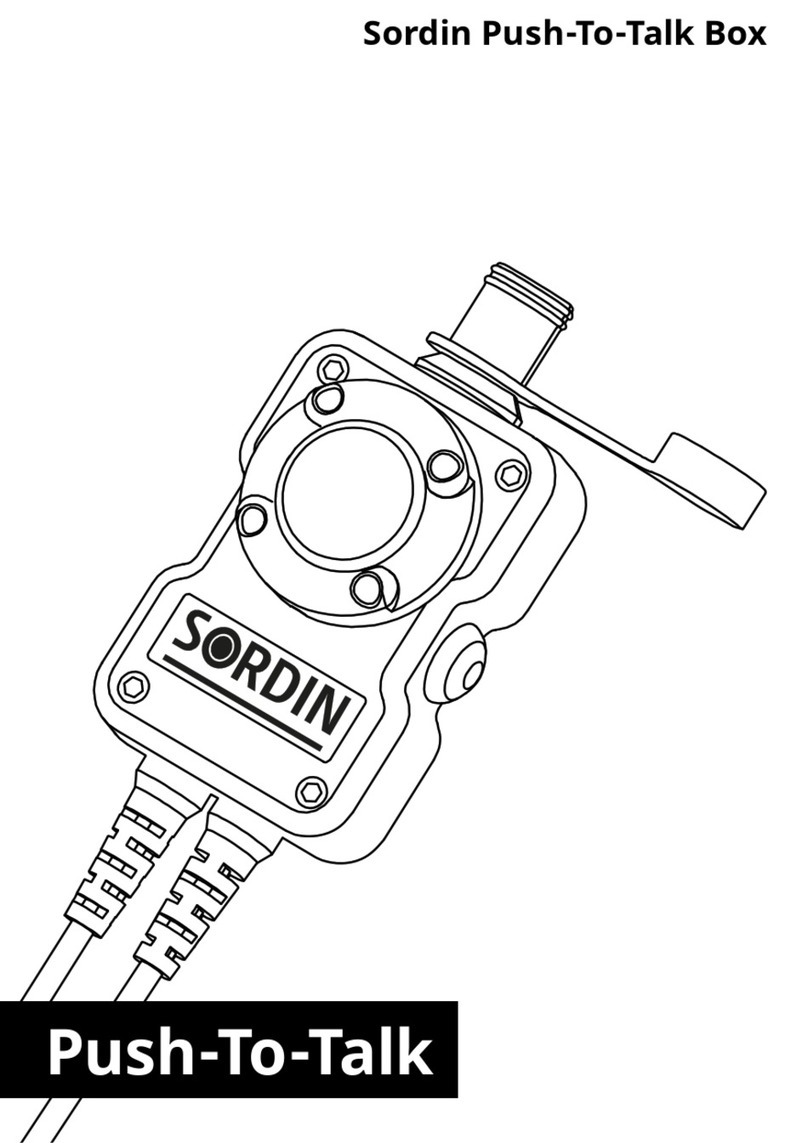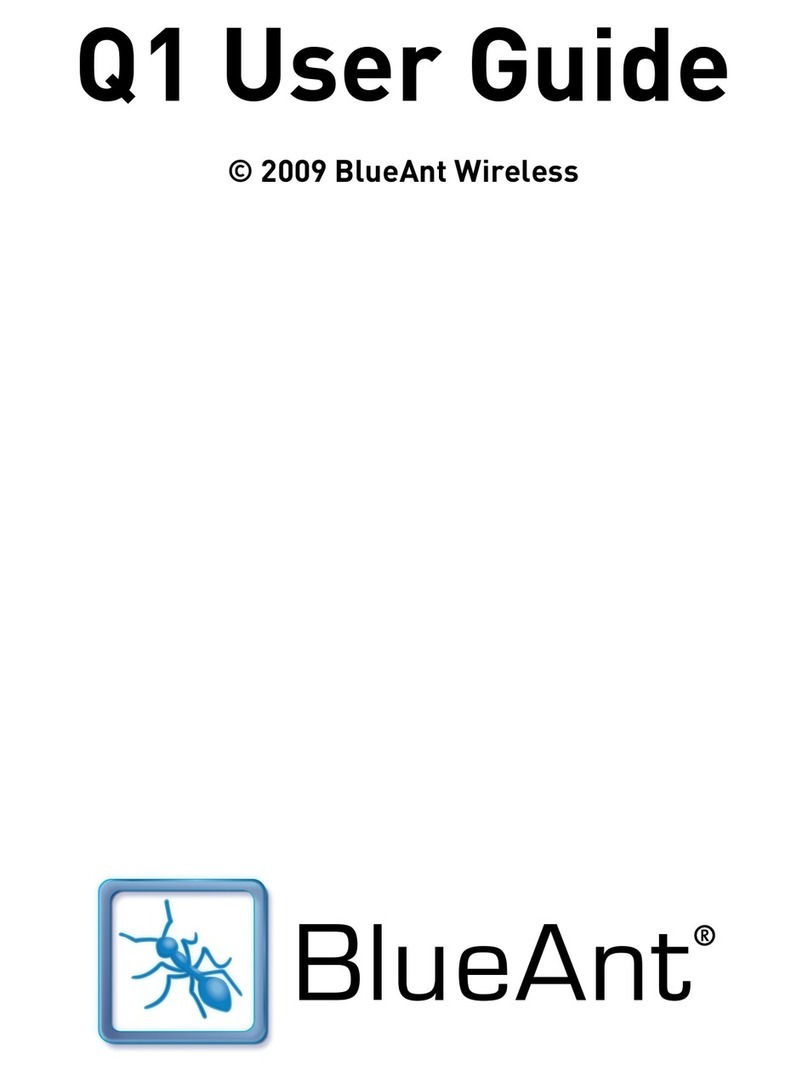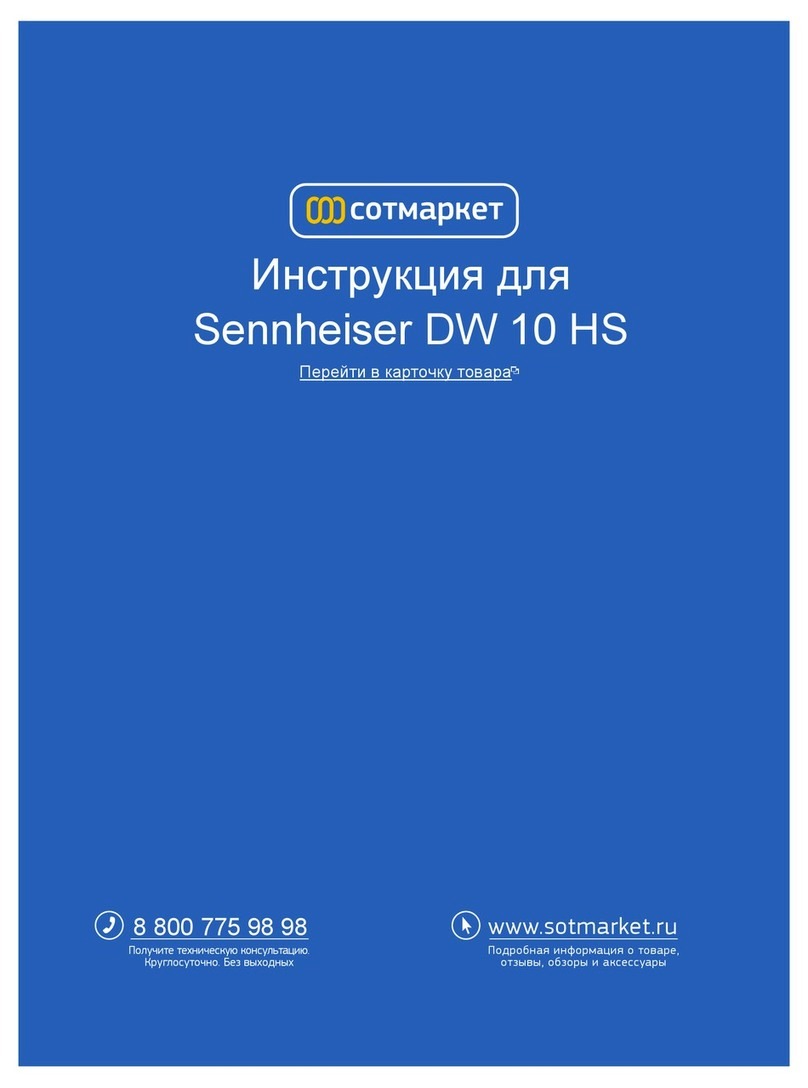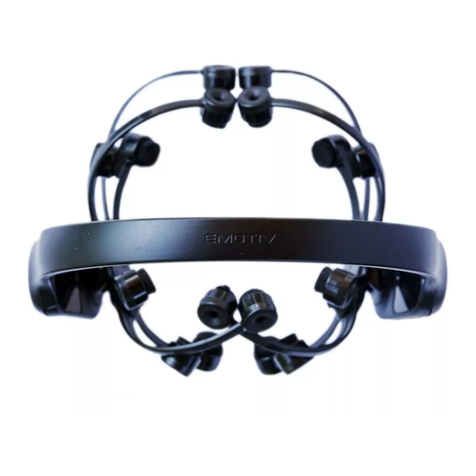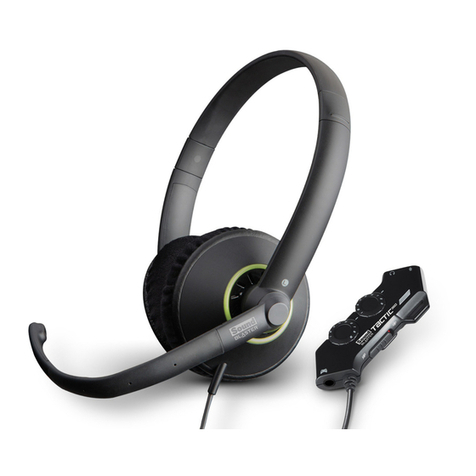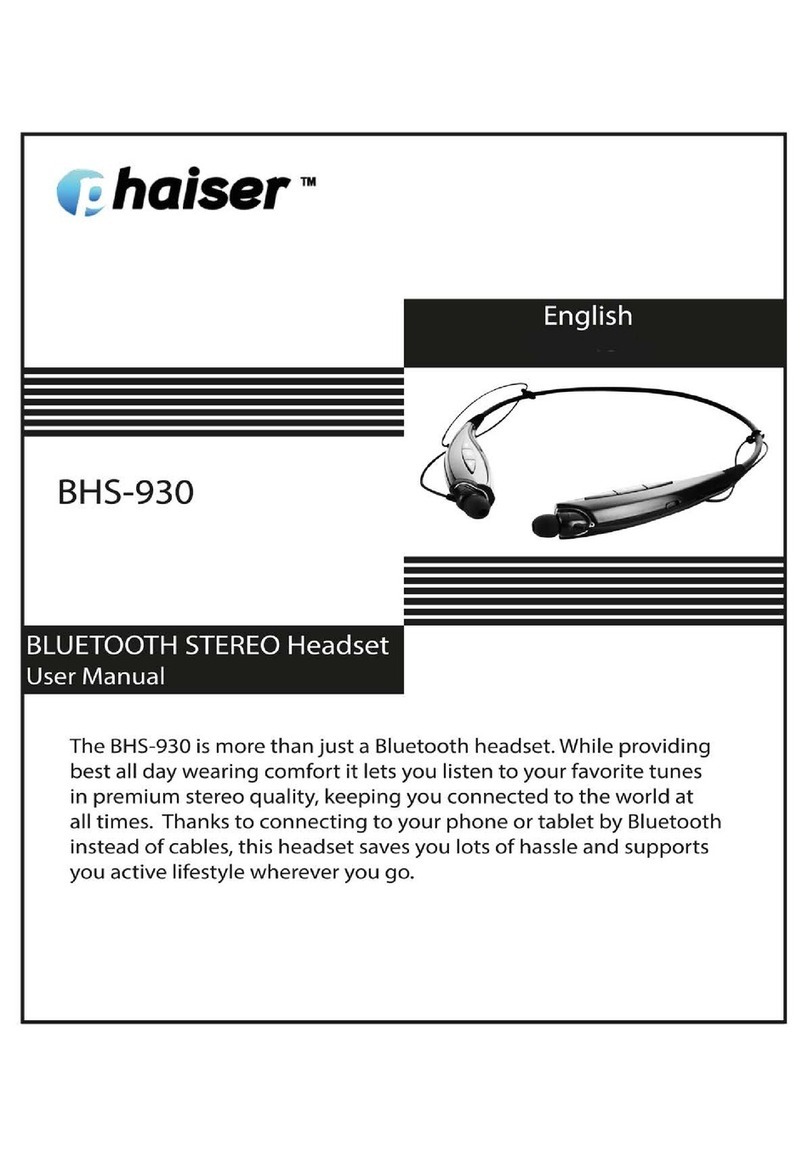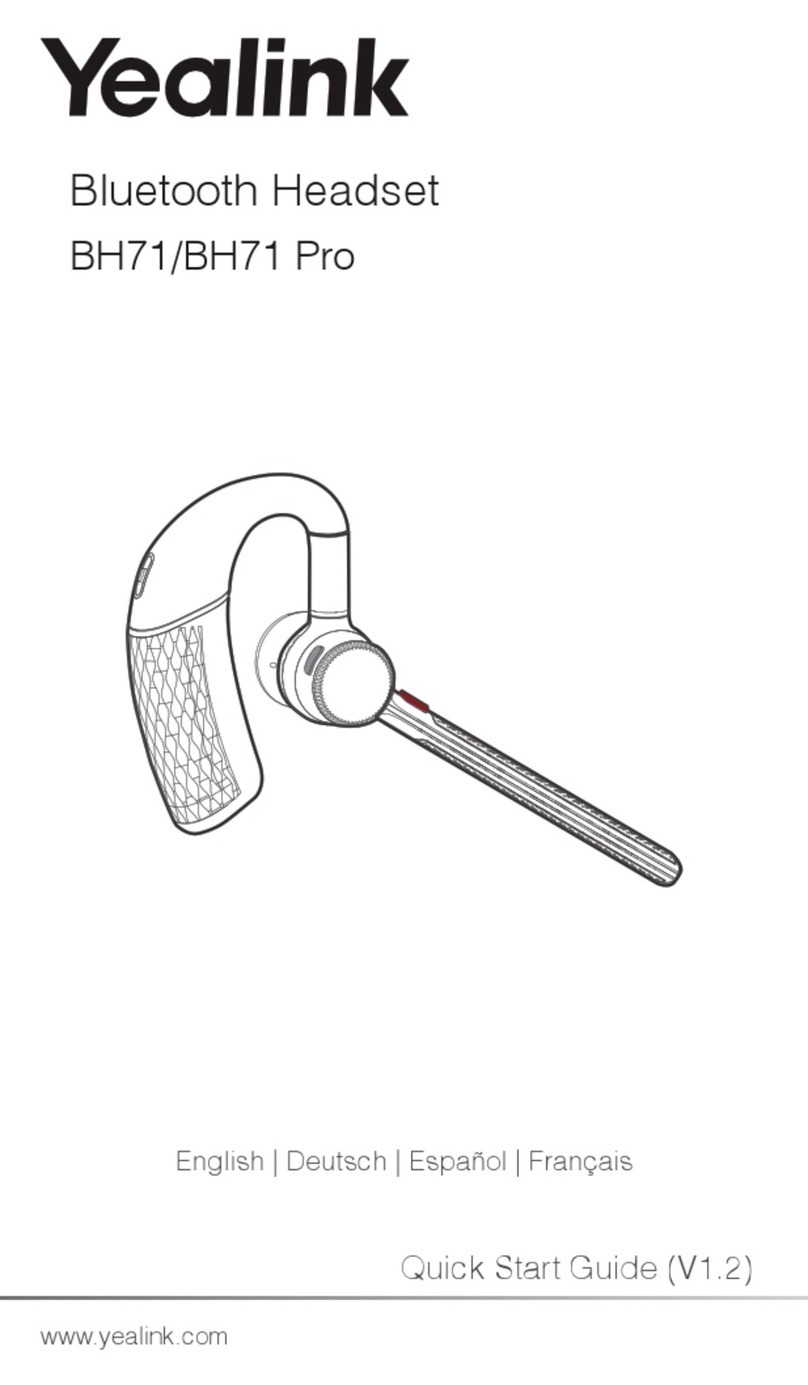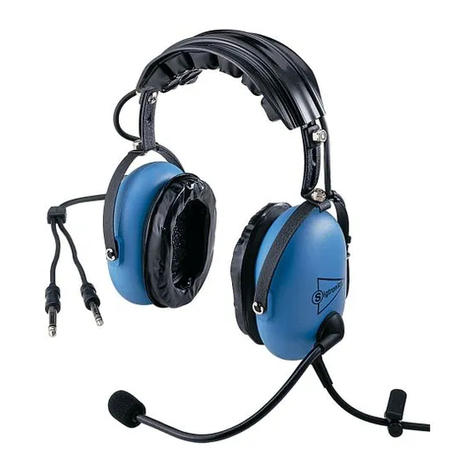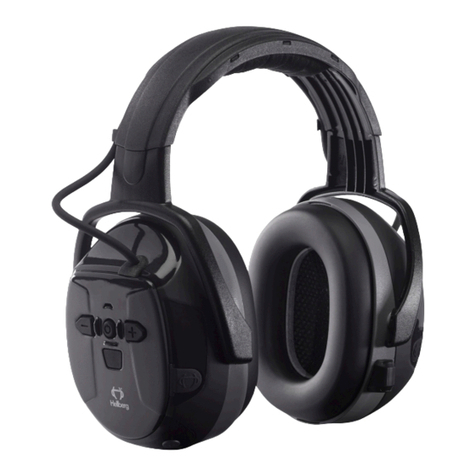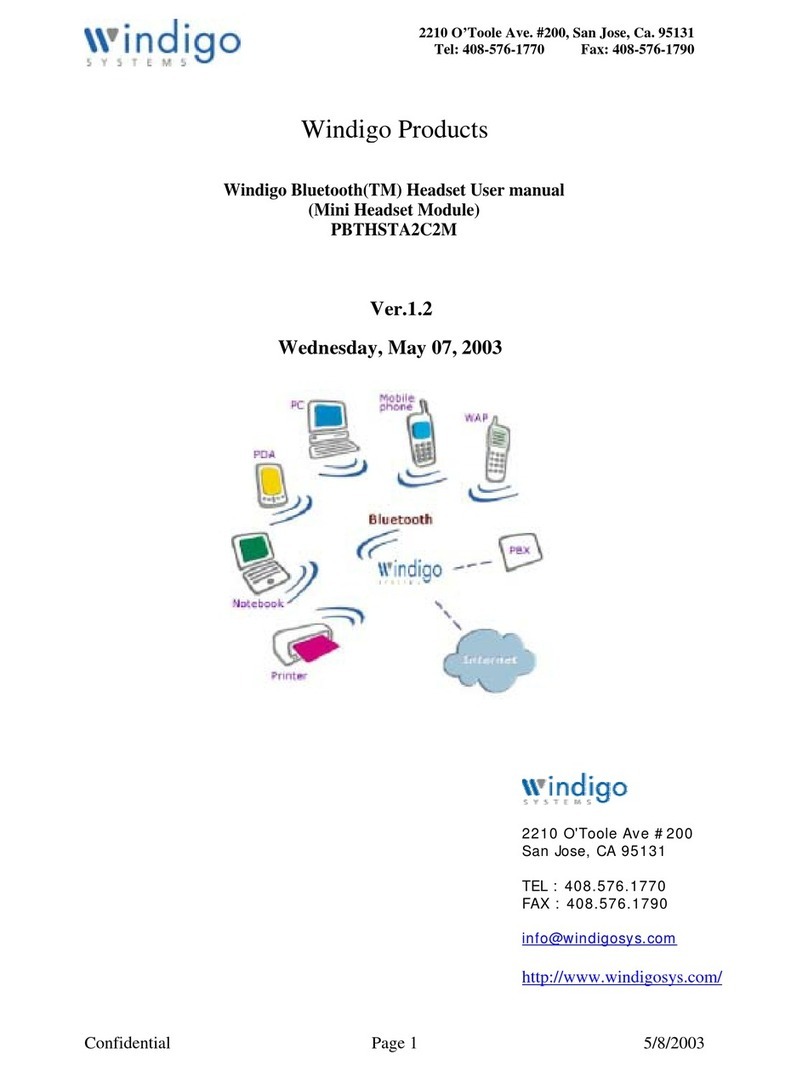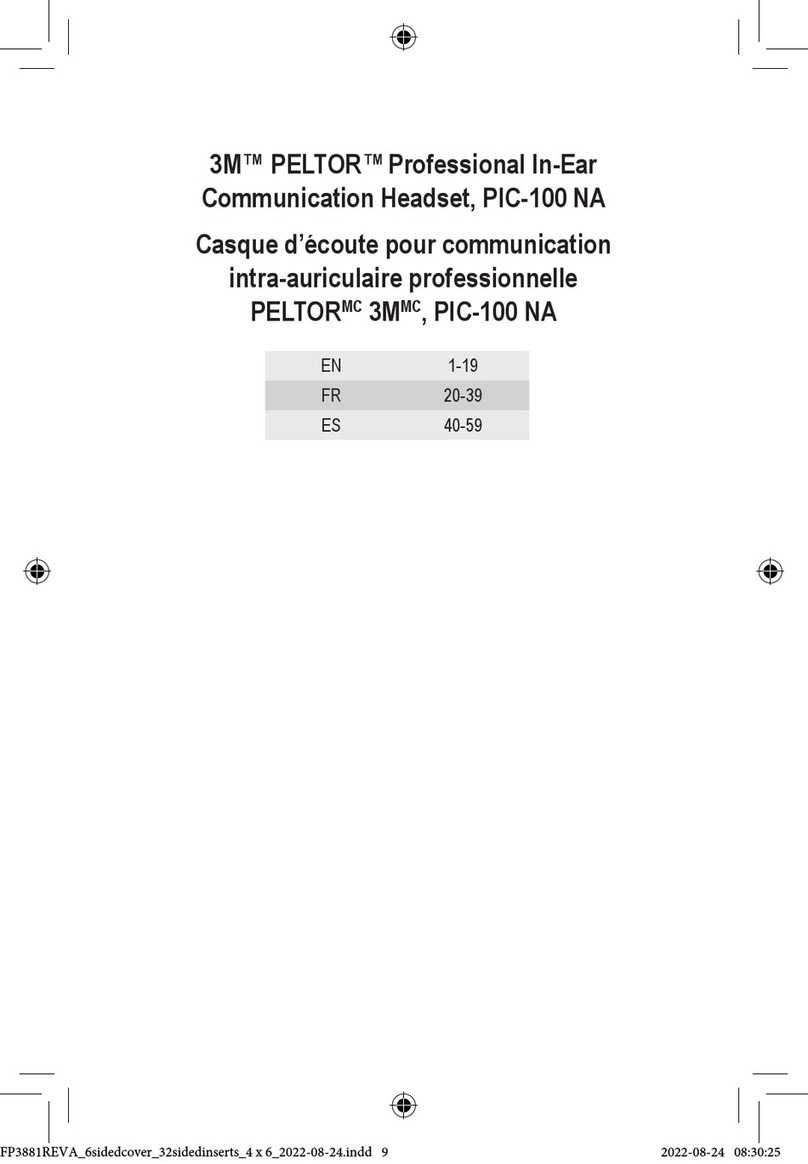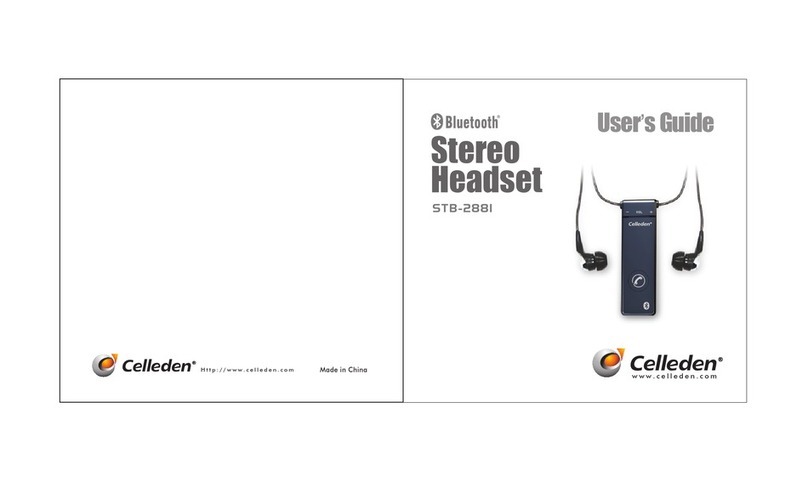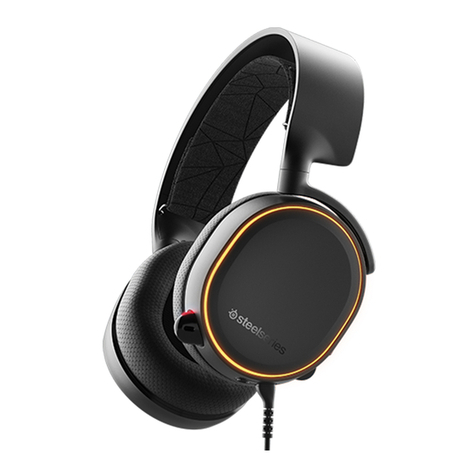Sordin left/RIGHT CC User manual

Hearing Protector
for Communication
Radios and
Ambient Listening
left/RIGHT™CC
left/RIGHT™CO CC

2
A1
B1
B4
B7
D
G H
A2
B2
B5
C1
E1
B3
B
B6
C2
E2

3
GB
DE
ES
FR
SE
DK
NO
FI
CZ
DESCRIPTION .............................................4
GERÄTEBESCHREIBUNG .............................9
DESCRIPCIÓN ............................................14
DESCRIPTION ...........................................19
PRODUKTEGENSKAPER ............................24
BESKRIVELSE ............................................29
BESKRIVELSE ...........................................34
KUVAUS ...................................................39
POPIS ......................................................44
left/RIGHT™CC
left/RIGHT™CO CC

4
INTRODUCTION
Sordin left/RIGHT CC and left/RIGHT CO CC are hearing protectors for connecting with communication
radios, and left/RIGHT CO CC also has ambient sound listening (CC = Connected by Cable, CO = Cut Off).
The products are designed to protect against harmful noise. The models Sordin left/RIGHT CC-1 and left/
RIGHT CO CC-1 are hearing protectors with headband and the models Sordin left/RIGHT CC-2 and left/
RIGHT CO CC-2 are hearing protectors for a helmet.
Key features
• Downlead for connection to communication radios.
• Noise cancelling boom microphone.
• Ambient sound listening for face-to-face communication with reduction of harmful noise (left/RIGHT
CO CC).
COMPLIANCE AND APPROVALS
The products meet the Essential Health and Safety Requirements as laid out in Annex II and conforms
with quality assurance of the production process, module D, laid out in Annex VIII of the PPE-regulation
(EU) 2016/425. CE markings are in accordance with EN 352-1:2020, EN 352-3:2020, EN 352-4:2020 and EN
352-6:2020. The products are approved to modules B and D by BSI (NB 2797), BSI Group The Netherlands
B.V. Say Building, John M. Keynesplein 9, 1066 EP Amsterdam, The Netherlands.
The product also complies with,
Directive 2001/95/EC General Product Safety.
IEC 62368-1 (EN 62368-1+A11), UL 62368-1:2014 Ed.2 and CSA C22.2#62368-1:2014 Ed.2
Audio/Video, information and communication technology equipment - Part 1: Safety Requirements
2006/66/EC Battery Directive
The battery is certied according to IEC62133 edition 2 and UN38.3.
Directive 2011/65/EU RoHS2 Restriction of hazardous substances.
Further information and the full text of the EU declaration of conformity is available at the following
internet address: www.sordin.com; search for left/RIGHT CC and left/RIGHT CO CC.
SAFETY
General safety
WARNING!
• Use and save these instructions.
• The noise attenuation of the product will be severely impaired if you do not follow the instructions in
this operator’s manual.
• The wearer should ensure that,
- the earmuffs are tted, adjusted and maintained in accordance with this manual.
- the earmuffs are worn at all times in noisy environments.
- the earmuffs are regularly inspected for serviceability
• This hearing protector (left/RIGHT CO CC) is provided with level-dependent attenuation. The wearer
should check correct operation before use. If distortion or failure is detected, the wearer should refer
to the manufacturers advice for maintenance and replacement of the battery.
• Performance may deteriorate with battery usage (left/RIGHT CO CC). The typical period of continuous
use that can be expected from the hearing protector battery varies depending on the mode of use and
volume output. The typical period of continuous use in ambient mode with mid-volume is 300 hours.
• The output level-dependent circuit of this hearing protector (left/RIGHT CO CC) may exceed the
external sound level.
GB left/RIGHT™CC, left/RIGHT™CO CC
PRODUCT LINE DESCRIPTION

5
• This hearing protector is provided with electrical audio input. The wearer should check correct
operation before use. If distortion or failure is detected, the wearer should refer to the manufacturers
advice.
• The output of the electrical audio circuit of this hearing protector may exceed the daily limit sound
level.
• This product may be adversely affected by certain chemical substances. Further information should be
sought from the manufacturer.
• Clean the product regularly. Use a cloth with water and soap. Do not wash or put fully into water.
• Earmuffs, and in particular cushions, may deteriorate with use and should be examined at frequent
intervals for cracking and leakage, for example.
• The tting of hygiene covers to the cushions, may affect the acoustic performance of the hearing
protectors.
• The product contains battery (left/RIGHT CO CC) and electrical components that may cause ignition
in ammable or explosive atmospheres. Do not use in environments where sparks may cause a re
or explosion.
• Do not put the product in storage at temperatures above +55°C and below -20°C.
• Only use the product between temperatures -20°C and +55°C.
• Ensure that the product is not damaged during transportation and use.
• Do not press the earmuffs against the helmet shell as this can cause cracks around the side of the
helmet.
• Do not change or remove parts on the product. Only do changes that are given in this manual. All
service and repair work must be done by an approved service workshop.
• Only use Sordin original spare parts.
• Never use the earmuffs longer than 10 years from the manufacturing date stated on the packaging.
• Dispose the product in accordance with national legislation.
OPERATION
Introduction
WARNING!
Before you operate the product, you must read and understand the safety chapter.
Before following the tting instructions, move your hair aside and remove any objects that could affect
acoustic seal. Make sure that the sealing rings are tight around your ears before you operate the product.
Headband Version (left/RIGHT CC-1 and CO CC-1) (Fig.A)
Make sure to put the headband the right way round. The inside of the headband is marked with a letter
L on the left hand side and a letter R on the right hand side. Ensure that the headband is positioned
correctly (Fig.A1). With the headband over the head, adjust the height of the cups by sliding them up or
down, so they completely enclose the ears (Fig.A2).
Helmet Mounted Version (left/RIGHT CC-2 and CO CC-2) (Fig.B)
These hearing protectors should be tted to, and used only, with industrial safety helmets and adapters
listed in Table 2. An adapter kit is provided with the the device. Before the hearing protectors can be
attached to the helmet, the correct adapter have to be installed. The adapter number can be found on
the adapter (Fig.D).
1. Attach the correct adapter (Fig.B) to the helmet.
2. Ensure that the cups are mounted on the correct side of the helmet. The cup marked with L must
be put on the left hand side of the helmet and the cup marked with R must be put on the right hand
side of the helmet (Fig.B1).
3. Pull the ear cup down the fork as far as possible and put the cup in stand-by-position (Fig.B2).
4. Push the attachment clip rmly into the slot on the side of the helmet until it clicks into place
(Fig.B3).

6
5. Detach the head harness at two places at the rear of the helmet and place the cord from the cups
above the harness attachment. Reattach the harness. Ensure the cord is not tangled.
6. For the working position, press the cups toward the ears until they click into place. Adjust the
height of the cups by sliding them up or down so they completely enclose the ears (Fig.B4).
7. Stand-by position: Pull the cups away from the ears until they lock into the stand-by position (Fig.
B5).
8. Parking position: From the stand-by position, rotate the cups to the rear of the helmet until they
click into place. In this position, the cushions do not get damaged or dirty and the cups can dry
(Fig.B6). NOTICE! Do not press the cups onto the helmet shell as this will lock the spring in the cup
arm, and damage the attachment slots on the side of the helmet.
9. Storage position: When the helmet is not in use, lower the cups and push them inwards until they
click into place (Fig.B7).
FUNCTIONS
Switch ON / OFF
Switch on the electronics by pressing the key [O]. To switch off, press the same key [O] and hold for 2
seconds (Fig.G1).
Volume Adjustment
When powered up, the default mode is volume mode. Adjust the volume with the [+] or [-] button on the
right cup. The volume has six xed settings. When pressing the volume buttons, a short beep sound is
heard. When reaching min or max volume, a longer beep sound is heard (Fig.G2).
Noise-Cancelling Boom Microphone
The earmuffs are equipped with a noise-cancelling speech microphone that is specially designed to work
in noisy environments. The product is supplied with an electret microphone. Adjust the boom microphone
so that the microphone is level with your mouth and about 3–5 mm from your lips. It is important not to
exceed this distance when working in a noisy environment, in order to get the best performance from the
noise-cancelling microphone. We recommend that you keep the microphone in this position whether you
are talking or not. A wind protector should be used to prevent interference from wind noise.
Ambient Sound Listening (left/RIGHT CO CC)
These hearing protectors are equipped with electronics for reproducing ambient sounds (level
dependent function). Ambient sound is captured by two externally mounted microphones (Fig.G3) and
reproduced by speakers inside the cup at a safe level. The sound is reproduced in stereo to preserve or
improve direction location. This function is intended for use in environments where there is a need to
hear ambient sound, such as warning signals, conversation and trac. NOTICE! If the hearing protector
is swiched off, incoming signals from communication radio or mobile phone cannot be heard. The lowest
volume level shuts of the ambient listening.
Battery Saving Function (left/RIGHT CO CC)
To maximize battery life, the product is equipped with a battery-saving function. This function
automatically switches off the electronics after 4 hours if none of the keys is pressed during this period.
To switch back on, press the key in the middle of the keypad (O). About 2 minutes before automatic switch-
off occurs, a series of beeps will be heard as a warning that the hearing protector is about to be switched
off. Press any key to delay switch-off by a further 4 hours.
Low Battery Warning (left/RIGHT CO CC)
Two tones will be heard when about 10-20 percent of the battery life remains. The battery warning is
repeated every half hour until the batteries are completely discharged.
Battery Replacement (left/RIGHT CO CC)
The product must be equipped with two standard alkaline batteries, 1.5 V AA/LR6. The use of
rechargeable batteries such as NiMH 1.2 V or NiCd 1.2 V will signicantly reduce the operating time. The
battery compartment is located in the left cup. To install new batteries, remove the lid (Fig.E1) and insert
the batteries. Make sure that the + and – poles are correctly aligned (Fig.E2). Replace the lid. The product
should be turned off during battery replacement.

7
Cable and Contact
The hearing protector is equipped with cable and plug for connection to external communication devices,
like communication radios or mobile phones.
Push To Talk (PTT)
The PTT button is placed behind the boom microphone on the left ear cup (Fig.H).
• Connect the headset to the communication radio or mobile phone.
• Switch the communication radio on and adjust the volume to the desired level.
• Keep the PTT button pressed while transmitting and release the PTT button to receive if you connect
the headset to a communication radio.
• Push the PTT button shortly to answer or hang up if you connect the headset to a mobile phone.
• Incoming radio signals will be heard in both the right and left cup.
MAINTENANCE
WARNING!
Do not wash or put fully into water.
Clean the product regularly. Use a cloth with water and soap and dry them carefully.
Check the condition of the sealing rings and the foam rubber inserts before each use. Replace the sealing
rings and the foam rubber inserts 1 time each 6 months or more frequently if it is necessary. Use original
spare parts (Fig.C1 and C2 and Table 3).
TRANSPORTATION, STORAGE AND DISPOSAL
Transportation and storage
When the hearing protector is not in use, store in dry and clean place at normal room temperature and
do not place in direct sunlight.
• Make sure that the sealing rings are not compressed.
• Make sure that the headband is not stretched (left/RIGHT CC-1 and CO CC-1).
• When the helmet is not in use, put the earmuffs in operating position.
NOTICE! Do not press the cups onto the helmet shell as this will lock the spring in the earmuff arm, and
damage the attachment slots on the side of the helmet (left/RIGHT CC-2 and CO CC-2) (Fig.B6).
Disposal
Follow national regulations for disposal of product.
ACCESSORIES
Approved sizes (left/RIGHT CC-1 and CO CC-1)
Over-the-head earmuff size ranges: Small-Medium-Large.
Approved helmets (left/RIGHT CC-2 and CO CC-2)
These earmuffs shall be tted to, and used only with, the industrial safety helmets as listed in Table 2. For
an updated list of approved helmet combinations, visit www.sordin.com.
WARNING!
Helmet mounted hearing protectors complying with EN 352-3 are of ‘medium size range’ or ‘small size
range’ or ‘large size range’. ‘Medium size range’ helmet mounted hearing protectors will t the majority
of wearers. ‘Small size range’ or ‘large size range’ helmet mounted hearing protectors are designed to t
wearers for whom ‘medium size range’ helmet mounted earmuffs are not suitable.

8
ATTENUATION DATA (Table 1)
Responsible manufacturer: Sordin AB, Rörläggarvägen 8, SE-331 53 Värnamo, Sweden, tel: +46-370-69
35 50.
f = Frequencies at which attenuation is measured
Mf= Mean value
sf= Standard deviation
APV (Mf–sf) = Assumed Protection Value
H = High frequency attenuation value (predicted noise level reduction for noise where LC–LA= –2 dB)
M = Medium frequency attenuation value (predicted noise level reduction for noise where LC–LA= +2 dB)
L = Low frequency attenuation value (predicted noise level reduction for noise where LC–LA= +10 dB)
SNR = Single Number Rating (the value that is subtracted from the measured C-weighted sound pressure
level, LC, in order to estimate the effective A-weighted sound level inside the ear)
W = Weight (gram)
CRITERION LEVELS (Table 4)
Typical values in accordance with EN 352-4:2001/A1:2005, appendix A, with the volume set to maximum.
H = High frequency sound pressure level (LC–LA= 1.2 dB),
M = Medium frequency sound pressure level (LC–LA= 2 dB),
L = Low frequency sound pressure level (LC–LA= 6 dB).
MATERIALS
PARTS MATERIALS
Cups ABS
Attenuation foam PE (Polyether)
Sealing rings PVC, PU foam
Headband 1POM
Cup supporting arm 2PA (Polyamide)
PARTS MATERIALS
Adapter, Holder 2PA (Polyamide)
Height adjustment brushings TPE
Spring cover 2TPE
Helmet spring 2Stainless steel
Screws Stainless steel
1Sordin left/RIGHT CC-1 and CO CC-1 (Headband), 2Sordin left/RIGHT CC-2 and CO CC-2 (Helmet mounted)

9
DE BESCHREIBUNG DER PRODUKTLINIE
left/RIGHT™CC, left/RIGHT™CO CC
EINFÜHRUNG
Sordin left/RIGHT CC und left/RIGHT CO CC sind Gehörschützer zur Verbindung mit Kommunikations-
funkgeräten, während left/RIGHT CO CC auch über eine Funktion verfügt, die das Hören von Umgebungs-
geräuschen ermöglicht (CC = Connected by Cable (per Kabel verbunden), CO = Cut Off (Abschirmung
von Geräuschen über dem Grenzwert)). Die Produkte dienen dem Schutz vor gesundheitsgefährdendem
Lärm. Bei den Modellen Sordin left/RIGHT CC-1 und left/RIGHT CO CC-1 handelt es sich um Gehörschutz
mit Kopfbügel, und bei den Modellen Sordin left/RIGHT CC-2 und left/RIGHT CO CC-2 um Gehörschutz
für einen Helm.
Wesentliche Merkmale
• Ableitung für die Verbindung mit Kommunikationsfunkgeräten.
• Galgenmikrofon mit Geräuschunterdrückung.
• Umgebungshörfunktion für persönliche Kommunikation bei gleichzeitiger Reduzierung schädlichen
Lärms (left/RIGHT CO CC).
KONFORMITÄT UND ZULASSUNGEN
Die Produkte erfüllen die grundlegenden Sicherheits- und Gesundheitsanforderungen gemäß Anhang II
und entsprechen der Qualitätssicherung des Produktionsprozesses, Modul D, gemäß Anhang VIII der
PSA-Verordnung (EU) 2016/425. Die CE-Kennzeichnungen erfolgten gemäß EN 352–1:2020, EN 352–3:2020,
EN 352–4:2020 und EN 352–6:2020. Die Produkte sind zugelassen gemäß den Modulen B und D durch
BSI (NB 2797), BSI Group The Netherlands B.V. Say Building, John M. Keynesplein 9, 1066 EP Amsterdam,
Niederlande.
Das Produkt entspricht außerdem
Richtlinie 2001/95/EG über die allgemeine Produktsicherheit.
IEC 62368-1 (EN 62368-1+A11), UL 62368-1:2014 Ed.2 und CSA C22.2#62368-1:2014 Ed.2
Audio/Video, information and communication technology equipment - Part 1: Safety Requirements
Richtlinie 2006/66/EG über Batterien und Akkumulatoren sowie Altbatterien und Altakkumulatoren
Die Batterie ist zertiziert gemäß IEC62133 (2. Ausgabe) und UN38.3.
Richtlinie 2011/65/EU zur Beschränkung der Verwendung bestimmter gefährlicher Stoffe in Elektro- und
Elektronikgeräten.
Weitere Informationen und der vollständige Text der EU-Konformitätserklärung sind unter folgender
Internetadresse abrufbar: www.sordin.com; suchen Sie nach SHARE; suchen Sie nach left/RIGHT CC und
left/RIGHT CO CC.
SICHERHEIT
Allgemeine Sicherheit
WARNUNG:
• Lesen Sie diese Anleitung und bewahren Sie sie auf.
• Die Schalldämpfungswirkung des Produkts wird massiv beeinträchtigt, wenn die in der Betriebsan-
leitung enthaltenen Anweisungen nicht befolgt werden.
• Der Träger muss sicherstellen, dass
– die Kapselgehörschützer gut angepasst, eingestellt und entsprechend dieser Betriebsanleitung
gewartet werden
– die Kapselgehörschützer in lauten Umgebungen ununterbrochen getragen werden
– die Kapselgehörschützer regelmäßig auf ihre Funktionstüchtigkeit überprüft werden
• Dieser Gehörschutz (left/RIGHT CO CC) ist mit einer pegelabhängigen Geräuschdämpfung ausge-
stattet. Der Träger muss sich vor der Verwendung vergewissern, dass das Produkt richtig funktioniert.
Wenn Verzerrungen oder Störungen festgestellt werden, muss sich der Träger wegen Wartung und
Batteriewechsel an den Rat des Herstellers halten.

10
• DieLeistungkann bei zunehmendem Batterieverbrauch abnehmen (left/RIGHTCOCC). Bei Dauereinsatz
ist die übliche Laufzeit der Batterie der Gehörschützer von den Betriebsmodi und der Lautstärke
abhängig. Bei Dauereinsatz beträgt die übliche Nutzungsdauer im Umgebungswahrnehmungsmodus
bei mittlerer Lautstärke 300 Stunden.
• Der vom Ausgangspegel abhängige Schaltkreis dieses Gehörschützers (left/RIGHT CO CC) kann den
externen Geräuschpegel überschreiten.
• Dieser Gehörschützer ist mit einem elektrischen Audio-Eingang ausgestattet. Der Träger muss sich
vor der Verwendung vergewissern, dass das Produkt richtig funktioniert. Wenn Verzerrungen oder
Störungen festgestellt werden, muss sich der Träger an den Rat des Herstellers halten.
• Die Wiedergabe des elektrischen Audio-Schaltkreises dieses Gehörschützers kann die tägliche
Schalleinwirkungsgrenze überschreiten.
• Dieses Produkt kann von bestimmten chemischen Substanzen angegriffen werden. Weitere Angaben
können beim Hersteller angefordert werden.
• Reinigen Sie das Produkt regelmäßig. Verwenden Sie ein Tuch mit Wasser und Seife. Nicht waschen
oder vollständig in Wasser eintauchen.
• Kapselgehörschützer und insbesondere Ohrpolster können sich durch Gebrauch abnutzen und sollten
regelmäßig beispielsweise auf Risse und Undichtigkeiten untersucht werden.
• DieHygieneabdeckungenderOhrpolster könnendieakustische Leistungsfähigkeitdes Gehörschützers
beeinträchtigen.
• Dieses Produkt (left/RIGHT CO CC) enthält Batterien und elektrische Komponenten, die in
entzündlichen oder explosionsfähigen Atmosphären eine Zündung verursachen können. Verwenden
Sie sie nicht in Umgebungen, in denen Funken einen Brand oder eine Explosion auslösen können.
• Lagern Sie das Produkt nicht bei Temperaturen über +55 °C und unter -20 °C.
• Verwenden Sie das Produkt nur bei Temperaturen zwischen -20 °C und +55 °C.
• Stellen Sie sicher, dass das Produkt während des Transports und der Verwendung nicht beschädigt
wird.
• Drücken Sie die Gehörschutzkapseln nicht gegen den Helm. Dies kann Risse seitlich am Helm verur-
sachen.
• Ändern oder entfernen Sie keine Teile des Produkts. Es dürfen nur Änderungen vorgenommen werden,
die in dieser Betriebsanleitung angegeben sind. Alle Wartungs- und Reparaturarbeiten müssen von
einer zugelassenen Service-Werkstatt ausgeführt werden.
• Verwenden Sie nur Originalersatzteile von Sordin.
• Verwenden Sie die Kapselgehörschützer nie länger als 10 Jahre ab dem auf der Verpackung angege-
benen Herstellungsdatum.
• Entsorgen Sie das Produkt so, wie es in Ihrem Land gesetzlich vorgeschrieben ist.
BETRIEB
Einführung
WARNUNG:
Bevor Sie das Produkt in Betrieb nehmen, müssen Sie den Abschnitt Sicherheit lesen und verstehen.
Bevor Sie die Anweisungen zur richtigen Anpassung befolgen, streichen Sie Ihr Haar zurück und ent-
fernen Sie alle Objekte, die die akustische Abdichtung beeinträchtigen könnten. Achten Sie darauf, dass
die Dichtungsringe fest um Ihre Ohren anliegen, bevor Sie das Produkt in Betrieb nehmen
Kopfbügel-Version (left/RIGHT CC-1 und CO CC-1) (Abb. A)
Achten Sie darauf, dass Sie den Gehörschützer richtig aufsetzen. Die Innenseite des Kopfbügels ist mit
dem Buchstaben L für links und mit dem Buchstaben R für rechts markiert. Achten Sie darauf, dass der
Kopfbügel korrekt sitzt (Abb. A1). Nach dem Aufsetzen des Gehörschützers müssen die Kapseln in die
richtige Position gebracht werden, indem Sie sie nach oben oder unten bewegen, so dass die Ohren
vollständig abgedeckt werden (Abb. A2).
Helm-Version (left/RIGHT CC-2 und CO CC-2) (Abb. B)
Dieser Gehörschutz sollte nur an den in Tabelle 2 aufgeführten Industrieschutzhelmen und Adaptern
montiert bzw. mit diesen verwendet werden. Ein Adapterkit ist im Lieferumfang des Produkts enthalten.

11
Bevor der Gehörschutz am Helm montiert werden kann, muss der korrekte Adapter angebracht werden.
Die Adapternummer bendet sich auf dem Adapter (Abb. D).
1. Den richtigen Adapter (Abb. B) am Helm anbringen.
2. Vergewissern Sie sich, dass die Kapseln an der richtigen Seite des Helms montiert werden. Die mit
L gekennzeichnete Kapsel muss sich auf der linken Seite und die mit R gekennzeichnete Kapsel auf
der rechten Seite des Helms benden (Abb. B1).
3. Ziehen Sie die Kapsel soweit wie möglich die Gabel hinunter und stellen Sie sie in Bereitschafts-
position (siehe Abb. B2).
4. Drücken Sie den Anschlussclip fest in die Aufnahme an der Helmseite, bis sie einrastet (Abb. B3).
5. Lösen Sie die Kopfbänderung an zwei Stellen von der hinteren Seite des Helms und führen Sie das
Kabel von den Kapseln über den Bänderungsanschluss. Bringen Sie die Bänderung wieder an.
Stellen Sie sicher, dass das Kabel nicht verdreht ist.
6. Drücken Sie die Kapseln zum Einnehmen der Arbeitsposition in Richtung der Ohren, bis sie ein-
rasten. Die Kapseln müssen in die richtige Position gebracht werden, indem Sie sie so nach oben
oder unten bewegen, bis die Ohren vollständig bedeckt werden (Abb. B4).
7. Bereitschaftsposition: Ziehen Sie die Kapseln vom Ohr weg, bis sie in der Bereitschaftsposition
einrasten (Abb. B5).
8. Parkposition: Drehen Sie die Kapseln von der Bereitschaftsposition zur Rückseite des Helms, bis
sie einrasten. In dieser Position können die Polster nicht beschädigt oder verunreinigt werden,
und die Kapseln können trocknen (Abb. B6). WICHTIGER HINWEIS! Drücken Sie die Kapseln nicht
in den Helm hinein, da dann die Federn der Haltebügel einrasten und die Befestigungssteckplätze
innerhalb des Helms beschädigt werden.
9. Lagerungsposition: Wenn der Helm nicht in Gebrauch ist, bewegen Sie die Kapseln nach unten
und drücken Sie sie nach innen, bis sie einrasten (Abb. B7).
Funktionen
Schalter ON/OFF (Ein/Aus)
Schalten Sie die Elektronik durch Drücken der Taste [O] ein. Zum Ausschalten drücken Sie dieselbe Taste
[O] und halten Sie sie zwei Sekunden lang gedrückt (Abb. G1).
Einstellung der Lautstärke
Beim Einschalten ist der Standardmodus der Lautstärkemodus. Stellen Sie die Lautstärke mit den Tasten
[+] und [-] auf der rechten Kapsel ein. Die Lautstärke hat sechs feste Einstellungen. Beim Drücken der
Lautstärketasten ertönt ein kurzer Ton. Wenn die minimale oder maximale Lautstärke erreicht ist, ertönt
ein längerer Ton (Abb. G2).
Galgenmikrofon mit Geräuschunterdrückung.
Die Kapselgehörschützer sind mit einem Sprechmikrofon mit Geräuschunterdrückung ausgestattet,
das speziell für den Einsatz in lauten Umgebungen entwickelt wurde. Das Produkt wird mit einem
Elektretmikrofon geliefert. Stellen Sie das Galgenmikrofon so ein, dass es auf gleicher Höhe mit Ihrem
Mund und etwa 3–5 mm von Ihren Lippen entfernt ist. Es ist wichtig, diesen Abstand bei der Arbeit in
lauten Umgebungen nicht zu überschreiten, damit das geräuschunterdrückende Mikrofon optimal
arbeitet. Wir empfehlen, das Mikrofon in dieser Position zu halten, unabhängig davon, ob Sie sprechen
oder nicht. Ein Windschutz sollte verwendet werden, um Störungen durch Windgeräusche zu verhindern.
Umgebungshörfunktion (left/RIGHT CO CC)
Diese Gehörschützer sind mit einer elektronischen Funktion ausgerüstet, welche die Wiedergabe von
Umgebungsgeräuschen ermöglicht (geräuschpegelabhängige Geräuschdämpfung). Umgebungsge-
räusche werden von zwei extern befestigten Mikrofonen (Abb. G3) erfasst und von den Lautsprechern
im Inneren der Kapsel auf einem sicheren Pegel wiedergegeben. Das Geräusch wird in Stereo wieder-
gegeben, um die Richtungserkennung aufrechtzuerhalten oder zu verbessern. Diese Funktion wird in
Umgebungen benutzt, in denen es wichtig ist, Umgebungsgeräusche wie Warnsignale, Gespräche und
Verkehr zu hören. WICHTIGER HINWEIS! Wenn der Gehörschützer ausgeschaltet ist, sind eingehende
Signale vom Kommunikationsfunkgerät oder Mobiltelefon nicht zu hören. Auf der niedrigsten Lautstärke
ist die Umgebungswahrnehmung abgeschaltet.

12
Batteriesparfunktion (left/RIGHT CO CC)
Um eine möglichst hohe Lebensdauer der Batterien zu ermöglichen, ist das Produkt mit einer Funktion
zur Schonung der Batterien ausgestattet. Wenn keine Tasten betätigt werden, wird diese Funktion nach
vier Stunden aktiviert und das Radio wird ausgeschaltet. Um es wieder einzuschalten, drücken Sie die
Taste in der Mitte der Tastatur (O). Ungefähr zwei Minuten vor Eintritt der automatischen Ausschaltung ist
eine Reihe von Pieptönen als Warnung dafür zu vernehmen, dass der Gehörschutz gleich ausgeschaltet
wird. Drücken Sie eine beliebige Taste, um die Ausschaltung um weitere vier Stunden hinauszuzögern.
Warnung bei schwacher Batterie (left/RIGHT CO CC)
Bei einer verbleibenden Batterielebensdauer von ungefähr 10–20 Prozent sind zwei akustische Signale zu
hören. Die Batteriewarnung wird halbstundenweise wiederholt, bis die Batterien völlig erschöpft sind.
Batteriewechsel (left/RIGHT CO CC)
Das Produkt muss mit zwei Standard-Alkaline-Batterien (1,5 V AA/LR6) betrieben werden. Bei der Ver-
wen dung von wiederauadbaren Akkus wie zum Beispiel NiMH 1,2 V oder NiCd 1,2 V verringert sich
die Betriebszeit erheblich. Das Batteriefach bendet sich in der linken Kapsel. Um neue Batterien ein-
zusetzen, entfernen Sie den Deckel (Abb. E1) und setzen Sie die Batterien ein. Achten Sie darauf, dass der
Plus- und der Minuspol richtig angeordnet sind (Abb. E2). Setzen Sie den Deckel wieder ein. Das Produkt
sollte während des Austauschs der Batterien ausgeschaltet werden.
Kabel und Kontakt
Der Gehörschutz ist mit Kabel und Stecker zum Anschluss an externe Kommunikationsgeräte wie Kom-
munikationsfunkgeräte oder Mobiltelefone ausgestattet.
Push To Talk (PTT)
Die PTT-Taste bendet sich hinter dem Galgenmikrofon an der linken Ohrkapsel (Abb. H).
• Verbinden Sie das Headset mit dem Kommunikationsfunkgerät oder Mobiltelefon.
• Schalten Sie das Kommunikationsfunkgerät ein und stellen Sie die gewünschte Lautstärke ein.
• Halten Sie die PTT-Taste während der Übertragung gedrückt und lassen Sie die PTT-Taste los, um zu
empfangen, wenn Sie das Headset mit einem Kommunikationsfunkgerät verbinden.
• Drücken Sie kurz die PTT-Taste, um einen Anruf entgegenzunehmen oder aufzulegen, wenn Sie das
Headset mit einem Mobiltelefon verbinden.
• Eingehende Funksignale sind sowohl in der rechten als auch in der linken Kapsel hörbar.
WARNUNG:
Nicht waschen oder vollständig in Wasser eintauchen.
Reinigen Sie das Produkt regelmäßig. Verwenden Sie ein Tuch mit Wasser und Seife, um es vorsichtig
abzuwischen.
Überprüfen Sie vor jedem Gebrauch den Zustand der Dichtungsringe und der Schaumgummieinsätze.
Ersetzen Sie die Dichtungsringe und die Schaumgummieinsätze alle 6 Monate oder bei Bedarf öfter. Ver-
wenden Sie nur Originalersatzteile (Abb. C1 und C2 und Tabelle 3).
TRANSPORT, LAGERUNG UND ENTSORGUNG
Transport und Lagerung
Wenn der Gehörschützer nicht genutzt wird, lagern Sie ihn an einem trockenen und sauberen Ort bei
normaler Raumtemperatur, und setzen Sie ihn nicht direkter Sonneneinstrahlung aus.
• Achten Sie darauf, dass die Dichtungsringe nicht zusammengedrückt werden.
• Achten Sie darauf, dass der Kopfbügel nicht gespannt ist (left/RIGHT CC-1 und CO CC-1).
• Wenn der Helm nicht in Gebrauch ist, müssen sich die Kapselgehörschützer in der Betriebsstellung
benden.
WICHTIGER HINWEIS! Drücken Sie die Kapseln nicht in den Helm hinein, da dann die Federn der
Haltebügel einrasten und die Befestigungssteckplätze innerhalb des Helms beschädigt werden (left/
RIGHT CC-2 und CO CC-2) (Abb. B6).

13
Entsorgung
Befolgen Sie die nationalen Vorschriften für die Entsorgung des Produkts.
ZUBEHÖR
Zugelassene Größen (left/RIGHT CC-1 und CO CC-1)
Größenbereiche für Kapselgehörschützer: Klein–Mittel–Groß.
Zugelassene Helme (left/RIGHT CC-2 und CO CC-2)
Diese Kapselgehörschützer dürfen nur an den in Tabelle 2 aufgeführten Industrieschutzhelmen montiert
bzw. mit diesen verwendet werden. Eine aktualisierte Liste der zugelassenen Helmkombinationen nden
Sie auf www.sordin.com.
WARNUNG
Am Helm angebrachte Gehörschützer, die die EN 352-3 erfüllen, gibt es in den Größen „mittel“, „klein“
oder „groß“. Am Helm angebrachte Gehörschützer „mittlerer Größe“ passen den meisten Trägern. Die
am Helm angebrachten Gehörschützer „kleiner“ oder „großer Größe“ sind für Träger konzipiert, denen
die Kapselgehörschützer „mittlerer Größe“ nicht passen.
DÄMPFUNGSDATEN (TABELLE 1)
Verantwortlicher Hersteller: Sordin AB, Rörläggarvägen 8, SE-331 53 Värnamo, Schweden, Tel.: +46-370-
69 35 50.
f = Frequenzen, bei denen die Schalldämmung gemessen wurde
Mf= Mittelwert
sf= Standardabweichung
APV (Mf–sf) = Angenommene Schutzwirkung
H = Dämmwert hohe Frequenzen (erwartete Schalldämmung bei Geräuschen mit LC–LA= –2 dB)
M = Dämpfungswert im Mittelfrequenzbereich (voraussehbare Lärmdämpfung bei Geräuschen mit LC–LA
= +2 dB)
L = Dämpfungswert im Niedrigfrequenzbereich (voraussehbare Lärmdämpfung bei Geräuschen mit LC–LA
= +10 dB)
SNR = Single-Number-Rating-Wert (der Wert, der von dem gemessenen C-bewerteten Schalldruckpegel
LCsubtrahiert wird, um den effektiven A-bewerteten Schalldruckpegel im Ohr abzuschätzen
W = Weight (Gewicht)
BEURTEILUNGSPEGEL (TABELLE 4)
Typische Werte gemäß EN 352-4:2001/A1:2005, Anhang A, bei maximaler Lautstärkeeinstellung.
H = Schalldruckpegel hohe Frequenzen (LC–LA= 1.2 dB),
M = Schalldruckpegel mittlere Frequenzen (LC–LA= 2 dB),
L = Schalldruckpegel niedrige Frequenzen (LC–LA= 6 dB).
TEILE MATERIALIEN
Adapter, Halter 2PA (Polyamid)
Höheneinstellungsbuchsen TPE
Federdeckel2 TPE
Helmfeder2 Edelstahl
Schrauben Edelstahl
TEILE MATERIALIEN
Kapseln ABS
Dämpfungsschaum PE (Polyether)
Dichtungsringe PVC, PU-Schaum
Kopfbügel 1POM
Tragarm Kapsel 2 PA (Polyamid)
MATERIALIEN
1Sordin left/RIGHT CC-1 und CO CC-1 (Kopfbügel),
2Sordin left/RIGHT CC-2 und CO CC-2 (am Helm montiert)

14
ES left/RIGHT™CC, left/RIGHT™CO CC
DESCRIPCIÓN DE LA LÍNEA DE PRODUCTOS
INTRODUCCIÓN
Sordin left/RIGHT CC y left/RIGHT CO CC son protectores auditivos para conectar con radios de comu-
nicación, y left/RIGHT CO CC también tiene escucha de sonido ambiental (CC = Conectado por cable, CO
= desconexión). Los productos están diseñados para proteger contra ruidos perjudiciales. Los modelos
Sordin left/RIGHT CC-1 y left/RIGHT CO CC-1 son protectores auditivos con banda de cabeza y los modelos
Sordin left/RIGHT CC-2 y left/RIGHT CO CC-2 son protectores auditivos para casco.
Características principales
• Bajada para la conexión a radios de comunicación.
• Micrófono de brazo con cancelación de ruido.
• Escucha de sonido ambiente para una comunicación cara a cara con reducción de ruidos molestos
(left/RIGHT CO CC).
CONFORMIDAD Y HOMOLOGACIONES
Los productos cumplen con los requisitos esenciales de salud y seguridad establecidos en el anexo II y
se ajustan al control de calidad del proceso de producción, módulo D, establecido en el anexo VIII del
reglamento de EPI (UE) 2016/425. Los marcados CE cumplen las normas, EN 352-1:2020, EN 352-3:2020, EN
352-4:2020 y EN 352-6:2020. Los productos están homologados para los módulos B y D por BSI (NB 2797),
BSI Group The Netherlands B.V. Say Building, John M. Keynesplein 9, 1066 EP Ámsterdam, Países Bajos.
El producto también cumple con
la Directiva 2001/95/CE relativa a la seguridad general de los productos.
IEC 62368-1 (EN 62368-1+A11), UL 62368-1:2014 Ed.2 y CSA C22.2#62368-1:2014 Ed.2
Equipos de audio y vídeo, de tecnología de la información y la comunicación. Parte1: Requisitos de
seguridad
la Directiva relativa a las pilas 2006/66/CE
La pila está certicada conforme a IEC62133 edición 2 y UN38.3.
la Directiva 2011/65/UE RoHS2 sobre restricciones de sustancias peligrosas.
Encontrará más información y el texto completo de la Declaración UE de conformidad en la siguiente
dirección de internet: www.sordin.com; busque left/RIGHT CC y left/RIGHT CO CC.
SEGURIDAD
Seguridad general
ADVERTENCIA:
• Utilice y guarde estas instrucciones.
• La protección que ofrecen las orejeras se verá considerablemente limitada si no sigue las instrucciones
de este manual de usuario.
• El usuario debe asegurarse de
- que las orejeras estén montadas, ajustadas y mantenidas conforme a este manual;
- ponerse siempre las orejeras en entornos ruidosos;
- que las orejeras se revisen regularmente para comprobar su eciencia.
• Este protector auditivo (left/RIGHT CO CC) está equipado con atenuación dependiente del nivel de
ruido. El usuario debe comprobar su correcto funcionamiento antes del uso. En caso de detectar
distorsiones o fallos, el usuario debe recurrir al consejo del fabricante para el mantenimiento y la
sustitución de la pila.
• El rendimiento puede mermarse con el deterioro de las pilas (left/RIGHT CO CC). El periodo típico de
uso continuo que se puede esperar de la pila del protector auditivo varía en función del modo de uso
y del volumen de salida. El periodo típico de uso continuo en modo ambiente con volumen medio es
de 300 horas.

15
• La salida del circuito dependiente del nivel de ruido de este protector auditivo (left/RIGHT CO CC)
puede superar el nivel de sonido externo.
• Este protector auditivo está equipado con una entrada de audio eléctrica. El usuario debe comprobar
su correcto funcionamiento antes del uso. En caso de detectar distorsiones o fallos, el usuario debe
recurrir al consejo del fabricante.
• La salida del circuito eléctrico de audio de este protector auditivo puede superar el límite diario de
nivel de sonido.
• Este producto puede verse seriamente dañado por determinados productos químicos. Debe solicitarse
información detallada al fabricante.
• Limpie el producto periódicamente. Utilice un paño con agua y jabón. No lave ni sumerja el dispositivo
completamente en agua.
• Las orejeras, y particularmente las almohadillas, pueden deteriorarse con el uso y se deben examinar
periódicamente para detectar posibles grietas y fugas.
• La colocación de tapas higiénicas en las almohadillas puede afectar al rendimiento acústico de los
protectores auditivos.
• El producto contiene pilas (left/RIGHT CO CC) y componentes electrónicos que pueden causar ignición
en ambientes inamables o explosivos. No lo utilice en ambientes donde las chispas puedan provocar
un incendio o una explosión.
• No almacene el producto a temperaturas superiores a los +55 °C e inferiores a los –20 °C.
• Utilice el producto únicamente a temperaturas comprendidas entre los –20 y los +55 °C.
• Asegúrese de que el producto no se dañe durante su transporte y su uso.
• No presione las orejeras contra el cuerpo del casco, ya que esto podría provocar grietas en el lateral
del casco.
• No cambie ni retire ninguna pieza del producto. Realice únicamente las modicaciones indicadas en
este manual. Todos los trabajos de mantenimiento y reparación deben ser realizados por un taller de
servicio autorizado.
• Utilice únicamente piezas de repuesto originales de Sordin.
• No utilice nunca las orejeras durante más de 10 años desde la fecha de producción indicada en el
embalaje.
• Elimine el producto conforme a la legislación nacional.
FUNCIONAMIENTO
Introducción
ADVERTENCIA:
Antes de utilizar el producto, debe leer y comprender el capítulo sobre seguridad.
Antes de seguir las siguientes instrucciones de colocación, apártese el pelo de las orejas y quítese
cualquier objeto que pudiera afectar al sellado acústico. Asegúrese de que los anillos obturadores estén
bien apretados alrededor de sus orejas antes de utilizar el producto.
Versión con banda de cabeza (left/RIGHT CC-1 y CO CC-1) (Fig. A)
Asegúrese de colocar la banda de cabeza en la posición correcta. La parte interior de la banda de cabeza
está marcada con una L (left) en el lado izquierdo, y una R (right) en el lado derecho. Asegúrese de que la
banda de cabeza está correctamente colocada (Fig.A1). Con la banda de cabeza sobre la cabeza, ajuste
la altura de los casquetes deslizándolos hacia arriba o hacia abajo hasta que le tapen completamente las
orejas (Fig.A2).
Versión para montaje en casco (left/RIGHT CC-2 y CO CC-2) (Fig. B)
Estos protectores auditivos deben colocarse y utilizarse únicamente con los cascos de seguridad
industrial y los adaptadores enumerados en la Tabla 2. Con el dispositivo se suministra un kit adaptador.
Antes de montarse los protectores auditivos en el casco, es necesario instalar el adaptador correcto. El
número de adaptador se encuentra en el adaptador (Fig. D).

16
1. Acople el adaptador correcto (Fig. B) al casco.
2. Asegúrese de que los casquetes estén montados en el lado correcto del casco. El casquete
marcado con la letra L debe quedar en el lado izquierdo del casco, mientras que el casquete
marcado con la letra R debe quedar en el lado derecho del casco (Fig. B1).
3. Tire del casquete hacia abajo hasta el tope de la horquilla y coloque el casquete en la posición en
espera (Fig. B2).
4. Introduzca rmemente el clip de sujeción en la ranura que hay en el lateral del casco hasta que
enganche (Fig. B3).
5. Desate el arnés de cabeza de las dos partes posteriores del casco y coloque el cable de los
casquetes sobre la jación del arnés. Vuelva a colocar el arnés. Asegúrese de que el cable no
quede enredado.
6. Para la posición de trabajo, presione los casquetes en dirección a las orejas hasta que enganchen.
Ajuste la altura de los casquetes deslizándolos hacia arriba o hacia abajo hasta que le tapen
completamente las orejas (Fig.B4).
7. Posición en espera: Separe los casquetes de las orejas hasta que se bloqueen en la posición en
espera (Fig.B5).
8. Posición de reposo: Desde la posición en espera, gire los casquetes hacia la parte posterior
del casco hasta que enganchen. En esta posición, las almohadillas no se dañan ni ensucian, y
se pueden secar los casquetes (Fig.B6). AVISO: No presione los casquetes contra el cuerpo del
casco, ya que esto bloquearía el muelle del brazo del casquete y dañaría las ranuras de jación
del lateral del casco.
9. Posición de almacenamiento: Cuando no vaya a usar el casco, baje los casquetes y presiónelos
hacia adentro hasta que enganchen (Fig.B7).
Funciones
Activación/desactivación
Activa la electrónica pulsando la tecla [O]. Para desactivarla, mantenga pulsada la misma tecla [O]
durante 2 segundos (Fig.G1).
Regulación del volumen
Cuando se enciende, el modo predeterminado es el modo de volumen. Regule el volumen con el botón
[+] o [-] del casquete derecho. El volumen dispone de seis ajustes jos. Al pulsar los botones de volumen,
se oirá un breve pitido. Cuando se alcanza el volumen mínimo o máximo, se escucha un pitido más largo
(Fig. G2).
Micrófono de brazo con cancelación de ruido
Las orejeras están equipadas con un micrófono de voz con cancelación de ruido especialmente diseñado
para funcionar en entornos ruidosos. El producto se suministra con un micrófono de electreto. Ajuste el
micrófono de brazo de modo que el micrófono esté a la altura de la boca y a unos 3-5 mm de los labios.
Es importante no superar esta distancia cuando se trabaja en un entorno ruidoso para obtener el mejor
rendimiento del micrófono con cancelación de ruido. Le recomendamos que mantenga el micrófono
en esta posición tanto si habla como si no. Se debe utilizar un protector contra el viento para evitar
interferencias causadas por el ruido del viento.
Escucha de sonido ambiental (left/RIGHT CO CC)
Estos protectores auditivos están equipados con electrónica para la reproducción del sonido ambiental
(función dependiente del nivel de ruido). El sonido ambiental es capturado por dos micrófonos montados
en el exterior (Fig.G3) y reproducido por los altavoces interiores del casquete a un nivel seguro. El
sonido se reproduce en estéreo para preservar o mejorar la percepción de la dirección. Esta función
está diseñada para su uso en entornos donde es necesario oír el sonido ambiental, como señales de
advertencia, conversaciones y tráco. AVISO: Si el protector auditivo está apagado, no se pueden
escuchar las señales entrantes de la radio de comunicación ni del teléfono móvil. El nivel de volumen más
bajo interrumpe la escucha ambiental.
Función de ahorro de las pilas (left/RIGHT CO CC)
Para maximizar la vida útil de las pilas, el producto está equipado con una función de ahorro de energía.
Esta función apaga automáticamente el sistema electrónico después de 4 horas si no se pulsa ninguna
tecla durante dicho periodo de tiempo. Para volver a encenderlo, pulse la tecla situada en el centro del

17
teclado (O). Aproximadamente 2 minutos antes del apagado automático se oye una serie de señales
acústicas avisando de que el protector auditivo está a punto de apagarse. Pulse cualquier tecla para
retardar el apagado otras 4 horas.
Advertencia de nivel bajo de la batería (left/RIGHT CO CC)
Cuando quede aproximadamente del 10 al 20 % de la vida útil de las pilas, se oirán dos señales acústicas.
El aviso del nivel bajo de pilas se repite cada media hora hasta que las pilas se descargan por completo.
Sustitución de las pilas (left/RIGHT CO CC)
El producto debe equiparse con dos pilas alcalinas estándar AA/LR6 de 1,5 V. El uso de pilas recargables,
p. ej., NiMH de 1,2 V o NiCd de 1,2 V, reducirá signicativamente el tiempo de funcionamiento. El com par-
timento de las pilas se encuentra en el casquete izquierdo. Para instalar pilas nuevas, retire la tapa (Fig.E1)
e inserte las pilas. Asegúrese de que los polos + y – estén correctamente situados (Fig.E2). Vuelva a colocar
la tapa. El producto debe permanecer desconectado durante la sustitución de las pilas.
Cable y contacto
El protector auditivo está equipado con un cable y un enchufe para la conexión a dispositivos de comuni-
cación externos, como radios de comunicación o teléfonos móviles.
Pulsar para hablar (PTT)
El botón PTT está situado detrás del micrófono de brazo, en el auricular izquierdo (Fig. H).
• Conecte los auriculares a la radio de comunicación o al teléfono móvil.
• Encienda la radio de comunicación y ajuste el volumen al nivel deseado.
• Mantenga pulsado el botón PTT mientras transmite y suelte el botón PTT para recibir si conecta los
auriculares a una radio de comunicación.
• Pulse brevemente el botón PTT para responder o colgar si conecta los auriculares a un teléfono
móvil.
• Las señales de radio entrantes se oirán en el casquete derecho e izquierdo.
MANTENIMIENTO
ADVERTENCIA:
No lave ni sumerja el producto completamente en agua.
Limpie el producto periódicamente. Utilice un paño con agua y jabón , y seque cuidadosamente.
Antes de cada uso, compruebe el estado de los anillos obturadores y de las piezas de gomaespuma.
Sustituya los anillos obturadores y las piezas de gomaespuma una vez cada seis meses o con más
frecuencia si es necesario. Utilice piezas de repuesto originales (Fig. C1 y C2 y Tabla 3).
TRANSPORTE, ALMACENAMIENTO Y ELIMINACIÓN
Transporte y almacenamiento
Cuando no vaya a utilizar el protector auditivo, almacénelo en un lugar limpio y seco a una temperatura
ambiente normal y no lo coloque bajo la luz directa del sol.
• Asegúrese de que los anillos obturadores no estén comprimidos.
• Asegúrese de que la banda de cabeza no está estirada (left/RIGHT CC-1 y CO CC-1).
• Cuando no vaya a usar el casco, coloque las orejeras en la posición de funcionamiento.
AVISO: No presione los casquetes contra el cuerpo del casco, ya que esto bloquearía el muelle del brazo
de la orejera y dañaría las ranuras de jación del lateral del casco (left/RIGHT CC-2 y CO CC-2) (Fig. B6).
Eliminación
Cumpla las regulaciones nacionales sobre la eliminación de productos.
ACCESORIOS
Tamaños homologados (left/RIGHT CC-1 y CO CC-1)
Rangos de tamaños de orejeras sobre la cabeza: pequeño, mediano, grande.
Cascos homologados (left/RIGHT CC-2 y CO CC-2)
Estas orejeras deben montarse y utilizarse exclusivamente con los siguientes cascos de seguridad
industriales indicados en la Tabla 2. Para obtener una lista actualizada de las combinaciones de casco
homologadas, visite www.sordin.com.

18
ADVERTENCIA:
Los protectores auditivos montados en el casco que cumplen con la norma EN 352-3 son de la «gama de
tamaño medio», la «gama de tamaño pequeño» o la «gama de tamaño grande». Los protectores auditivos
montados en el casco de la «gama de tamaño medio» serán apropiados para la mayoría de los usuarios.
Los protectores auditivos montados en el casco de «rango de tamaño pequeño» o de «rango de tamaño
grande» han sido diseñados para aquellos usuarios para los que las orejeras de «rango de tamaño medio»
no resulten adecuadas.
DATOS DE ATENUACIÓN SONORA (TABLA 1)
Fabricante responsable: Sordin AB, Rörläggarvägen 8, SE-331 53 Värnamo, Suecia, tel: +46-370-69 35 50.
f = Frecuencias de medición de la atenuación de ruido
Mf= Valor medio
sf= Desviación estándar
APV (Mf–sf) = Efecto protector previsto
H = Valor de atenuación a alta frecuencia (reducción prevista del nivel de ruido para ruidos en los que
LC–LA= –2 dB)
M = Valor de atenuación a media frecuencia (reducción prevista del nivel de ruido para ruidos en los que
LC–LA= +2 dB)
L = Valor de atenuación a baja frecuencia (reducción prevista del nivel de ruido para ruidos en los que
LC–LA= +10 dB)
SNR = Índice de número simple (es el valor que se resta del nivel de presión acústica con ponderación C, LC,
para determinar el nivel efectivo de sonido con ponderación A en el interior de la oreja)
W = Peso
NIVELES DE CRITERIO (TABLA 4)
Valores típicos de conformidad con EN 352-4:2001/A1:2005, apéndice A, con el volumen ajustado al
máximo.
H = Nivel de presión acústica de alta frecuencia (LC–LA= 1.2 dB),
M = Nivel de presión acústica de frecuencia media (LC–LA= 2 dB),
L = Nivel de presión acústica para frecuencias bajas (LC–LA= 6 dB).
COMPONENTES MATERIALES
Adaptador, soporte 2PA (Poliamida)
Casquillos de ajuste de la altura TPE
Cubierta de muelle 2TPE
Resorte del casco 2Acero
inoxidable
Tornillos Acero
inoxidable
COMPONENTES MATERIALES
Casquetes ABS
Espuma atenuación PE (Poliéter)
Anillos obturadores PVC,
espuma de PU
Banda de cabeza 1POM
Brazo de soporte
del casquete 2PA (Poliamida)
MATERIALES
1Sordin left/RIGHT CC-1 y CO CC-1 (banda de cabeza),
2 Sordin left/RIGHT CC-2 y CO CC-2 (montaje en casco)

19
FR left/RIGHT™CC, left/RIGHT™CO CC
DESCRIPTION DE LA GAMME
INTRODUCTION
Sordin left/RIGHT CC et left/RIGHT CO CC sont des protections auditives à connecter aux radios de com-
munication. Sordin left/RIGHT CO CC permet également l’écoute du son ambiant (CC = connecté par
câble, CO = coupure). Les produits sont conçus pour protéger les utilisateurs des bruits nuisibles. Les
modèles Sordin left/RIGHT CC-1 et left/RIGHT CO CC-1 sont des protections auditives avec serre-tête.
Les modèles Sordin left/RIGHT CC-2 et left/RIGHT CO CC-2 sont des protections auditives pour casque.
Caractéristiques principales
• Câble d’alimentation « downlead » pour le raccordement aux radios de communication.
• Microphone à réduction de bruit.
• Écoute du son ambiant pour les communications en face à face avec réduction des bruits nuisibles
(left/RIGHT CO CC).
CONFORMITÉ ET HOMOLOGATION
Les produits répondent aux exigences essentielles de santé et de sécurité dénies à l’annexe II et
sont conformes à l’assurance qualité du procédé de production, module D, dénie à l’annexe VIII du
règlement (UE) 2016/425 sur les EPI. Marquages CE conformes aux normes EN 352-1:2020, EN 352-3:2020,
EN 352-4:2020 et EN 352-6:2020. Les produits sont conformes aux modules B et D de BSI (NB 2797), BSI
Group The Netherlands B.V. Say Building, John M. Keynesplein 9, 1066 EP Amsterdam, Pays-Bas.
Le produit est également conforme à la
directive 2001/95/CE relative à la sécurité générale des produits.
CEI 62368-1 (EN 62368-1+A11), UL 62368-1:2014 Ed.2 et CSA C22.2#62368-1:2014 Ed.2
Équipements des technologies de l’audio/vidéo, de l’information et de la communication – Partie 1 :
Exigences de sécurité
2006/66/CE Directive relative aux piles et accumulateurs
Les piles sont conformes à la norme CEI62133 édition 2 et UN38.3.
Directive 2011/65/UE RoHS2 relative à la limitation de l’utilisation de certaines substances dangereuses.
Plus d’informations et le texte intégral de la déclaration UE de conformité sont disponibles à l’adresse
internet suivante : www.sordin.com ; recherchez left/RIGHT CC et left/RIGHT CO CC.
SÉCURITÉ
Sécurité générale
AVERTISSEMENT:
• Lisez et conservez ces instructions.
• La capacité d’atténuation du bruit du produit peut être fortement diminuée en cas de non-respect des
instructions du présent manuel.
• L’utilisateur doit s’assurer que
- les protège-oreilles sont montés, réglés et entretenus conformément au présent manuel,
- les protège-oreilles sont systématiquement portés dans des environnements bruyants,
- les protège-oreilles sont régulièrement inspectés pour la maintenance.
• Cette protection auditive (left/RIGHT CO CC) est dotée d’une fonction de réduction active du bruit.
L’utilisateur doit vérier le fonctionnement correct de l’appareil avant de l’utiliser. En cas de distorsion
ou de dysfonctionnement, l’utilisateur doit suivre les conseils du fabricant pour la maintenance et le
remplacement des piles.
• Les performances peuvent se détériorer avec le déchargement des piles (left/RIGHT CO CC). La durée
d’utilisation en continu des piles de la protection auditive varie en fonction du mode d’utilisation et
du volume sonore. La durée d’utilisation en continu en mode ambiant et avec un volume moyen est
de 300 heures.

20
• Le circuit dépendant du niveau de sortie de cette protection auditive (left/RIGHT CO CC) peut dépasser
le niveau sonore externe.
• Cette protection auditive est munie d’une entrée audio électrique. L’utilisateur doit vérier le
fonctionnement correct de l’appareil avant de l’utiliser. En cas de distorsion ou de dysfonctionnement,
l’utilisateur doit suivre les conseils du fabricant.
• La sortie du circuit audio électrique de cette protection auditive peut dépasser le niveau sonore limite
quotidien.
• Certaines substances chimiques peuvent avoir un effet négatif sur ce produit. Demandez de plus
amples informations au fabricant.
• Nettoyez régulièrement le produit. Utilisez un chiffon avec de l’eau et du savon. Ne lavez pas le produit
à grande eau et ne le faites pas tremper.
• Les protège-oreilles, et en particulier les coussins, peuvent se détériorer à l’usage et doivent être
contrôlés à intervalles réguliers pour détecter notamment d’éventuelles ssures ou fuites.
• La mise en place de manchons hygiéniques sur les coussins peut affecter les performances acoustiques
des protections auditives.
• Le produit contient des piles (left/RIGHT CO CC) et des composants électriques pouvant provoquer un
incendie dans des atmosphères inammables ou explosives. Ne l’utilisez pas dans des environnements
où des étincelles peuvent provoquer un départ de feu ou une explosion.
• N’entreposez pas le produit à des températures supérieures à +55 °C et inférieures à -20 °C.
• Utilisez le produit uniquement entre -20 °C et +55 °C.
• Veillez à ce que rien ne vienne heurter le produit pendant son transport et son utilisation.
• N’appuyez pas les protège-oreilles contre la coque du casque, car cela pourrait ssurer le côté du
casque.
• Ne modiez et n’enlevez aucune pièce du produit. Effectuez uniquement les modications indiquées
dans le présent manuel. Les réparations et la maintenance doivent être effectuées par un atelier agréé.
• Utilisez uniquement des pièces de rechange d’origine Sordin.
• N’utilisez jamais les protège-oreilles plus de 10 ans à compter de la date de fabrication stipulée sur
l’emballage.
• Mettez le produit au rebut conformément à la législation nationale.
FONCTIONNEMENT
Introduction
AVERTISSEMENT:
avant d’utiliser le produit, vous devez lire et comprendre le chapitre sur la sécurité.
Avant de suivre les instructions de réglage ci-dessous, dégagez les cheveux des oreilles et retirez tout
objet susceptible de nuire à l’étanchéité acoustique. Assurez-vous que les bagues d’étanchéité sont bien
ajustées autour de vos oreilles avant d’utiliser le produit.
Version serre-tête (left/RIGHT CC-1 et CO CC-1) (Fig. A)
Assurez-vous de mettre le serre-tête correctement. L’intérieur du serre-tête est marqué par un L du côté
gauche et par un R du côté droit. Assurez-vous que le serre-tête est positionné correctement (Fig. A1). Une
fois le serre-tête bien en place, ajustez la hauteur des coquilles en les faisant coulisser vers le haut ou vers
le bas pour qu’elles enveloppent complètement les oreilles (Fig. A2).
Version montée sur casque (left/RIGHT CC-2 et CO CC-2) (Fig. B)
Ces protections auditives doivent uniquement être montées et utilisées avec des casques de sécurité
industriels et les adaptateurs répertoriés dans le Tableau 2. Un kit d’adaptateur est fourni avec le
dispositif. Installez le bon adaptateur avant de xer les protections auditives au casque. Le numéro de
l’adaptateur est indiqué sur l’adaptateur (Fig. D).
1. Fixez le bon adaptateur (Fig. B) sur le casque.
2. Assurez-vous que les coquilles sont montées du bon côté du casque. La coquille marquée par la
lettre L doit être placée du côté gauche du casque et celle marquée par la lettre R doit être placée
du côté droit (Fig. B1).
This manual suits for next models
1
Table of contents
Languages:
Other Sordin Headset manuals
